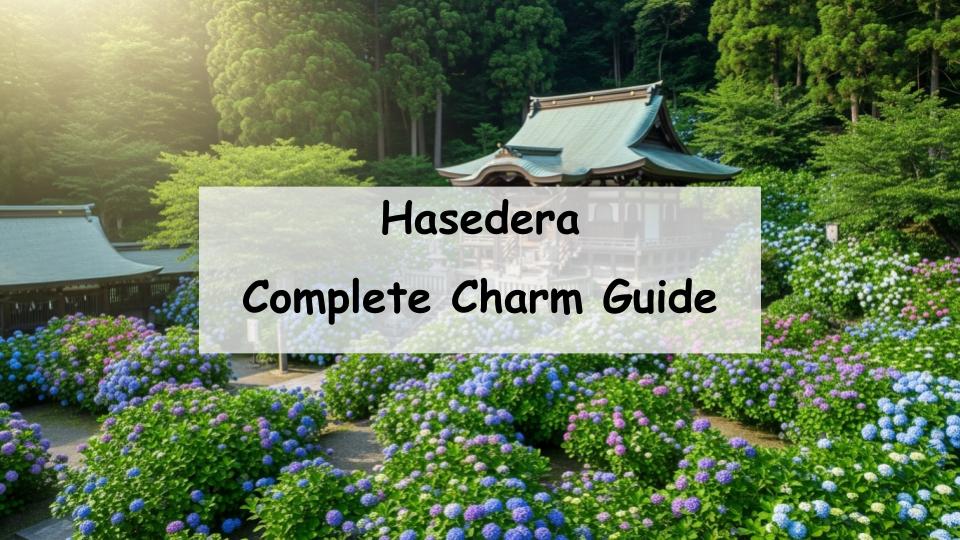If you want to learn more about Hasedera Temple but find yourself wondering, “What kind of temple is it?”, “What are the main attractions?”, or “How do I get there?”, you’re not alone. This article provides a clear and detailed introduction to Hasedera, one of Kamakura’s most famous temples. Known as a sacred site for Kannon worship, we will explore the temple’s history and architectural features, the seasonal beauty of its grounds, as well as practical information on access and tips for visitors. By reading this, you’ll have all the essential information you need before visiting, allowing you to plan a fulfilling trip.
- History and Background of Hasedera Temple
- Attractions and Features of Hasedera Temple
- Visiting Route and Highlights Around Hasedera
- Access and Visitor Information
- Important Tips Before Your Visit
- Recommended Spots Near Hasedera Temple
- Conclusion: Enjoying and Rediscovering the Charm of Hasedera
- A Message from the Guide
History and Background of Hasedera Temple
The Founding and Origin of Hasedera
Hasedera was founded during the Nara period, boasting a history of over 1,300 years. It has long been a center of Kannon worship, drawing countless devotees throughout the centuries. The temple’s name derives from the “Hase” area where the Kannon statue is enshrined.
Religious and Cultural Significance Since the Kamakura Period
During the Kamakura era, the temple prospered under the patronage of the samurai class. It holds high cultural value as an important temple in terms of architectural style and Buddhist art.
Attractions and Features of Hasedera Temple
The Kannon Hall and the Eleven-Faced Kannon Statue
The temple’s main highlight is the approximately 9-meter-tall Eleven-Faced Kannon statue housed in the Kannon Hall. This is one of the largest statues of its kind in Japan and a central object of worship.
Seasonal Nature and Scenic Views on the Grounds
The Charm of Hydrangeas
Hasedera is famous as a hydrangea spot, with colorful blooms covering the temple grounds in June. Visitors can enjoy the tranquil atmosphere while admiring these beautiful flowers.
Stunning Autumn Foliage
In autumn, the temple is adorned with vivid fall colors. The view from the observation deck is especially breathtaking, offering a harmonious blend of nature and history.
Gardens and Observation Deck Experience
The temple grounds feature meticulously maintained gardens perfect for leisurely walks. From the observation deck, you can enjoy panoramic views of Kamakura town and Sagami Bay, beautiful throughout the seasons.
Experience Sutra Copying and Collecting Goshuin Stamps
Visitors can participate in sutra-copying activities to deepen their connection to Buddhist teachings. Collecting goshuin (temple stamps) is also popular as a meaningful souvenir.
Visiting Route and Highlights Around Hasedera
The Path from Entrance to Main Hall
The smooth route from the entrance to the main hall passes charming tea houses and souvenir shops. Visitors can enjoy the historic architecture and gardens as they walk.
Observation Deck and Kannon Museum
The observation deck offers must-see views, and the Kannon Museum provides educational exhibits about the temple’s history and culture. There’s plenty to explore with ample time.
Access and Visitor Information
Access by Train and Bus
Hasedera is accessible via JR Kamakura Station or the Enoden Hase Station, with convenient bus or walking options available. Public transportation is recommended for ease.
Walking Routes from Kamakura and Hase Stations
From Hase Station, it’s about a 5-minute walk on a straightforward path, ideal for tourists. Kamakura Station is also within walking distance, although it’s slightly farther.
Access by Car and Parking Information
While there are nearby parking lots for those arriving by car, spaces are limited. Using public transportation is advisable to avoid hassle.
Important Tips Before Your Visit
Opening Hours and Admission Fees
Hasedera’s opening hours vary seasonally but are generally from 8:00 AM to 5:00 PM. Admission fees are a few hundred yen for adults. Checking the official website in advance is recommended.
Best Times to Avoid Crowds
Weekends and holidays tend to be busy, so visiting on weekdays or early mornings provides a more comfortable experience. The hydrangea season especially attracts many visitors.
Suggested Model Tours Including Nearby Attractions
Popular day trips combine a visit to Hasedera with stops at the Great Buddha (Kotoku-in) and coastal areas such as Yuigahama and Inamuragasaki.
Recommended Spots Near Hasedera Temple
Visiting the Great Buddha (Kotoku-in) Nearby
The Kamakura Daibutsu, located within walking distance, is a must-see companion destination. The historic giant Buddha statue offers an impressive sight.
Scenic Coastal Spots: Yuigahama and Inamuragasaki
Enjoy a relaxing walk along the coast with views that soothe the soul. The scenery changes beautifully with the seasons.
Cafes and Traditional Sweets Shops for a Break
After your visit, relaxing at Kamakura-style cafes or traditional sweet shops is a perfect way to unwind and recharge.
Conclusion: Enjoying and Rediscovering the Charm of Hasedera
A Comfortable Guide for First-Time Visitors
Hasedera is a temple where history and nature come together, offering a welcoming atmosphere even for first-time guests.
Why You’ll Want to Visit Again and Again
The seasonal landscapes, rich attractions, and cultural experiences make Hasedera a place to return to repeatedly. Explore its many charms over multiple visits.
A Message from the Guide

When I visited, it wasn’t hydrangea season, but I was still very satisfied just to enjoy the view overlooking the sea.









Comment